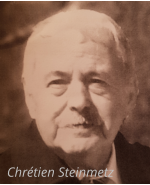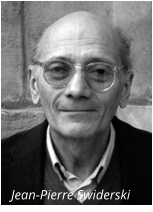


ORGANS OF PARIS © 2025 Vincent Hildebrandt HOME ALL ORGANS

Muhleisen
Pels-Dhondt
(Herselt,
Belgium).
Jean-Baptiste
D’Hondt
founded
a
small
organ
building
firm
in
1892
near
Brussels.
In
the
middle
of
the
XXth
century,
his
firm
merged
with
the
firm
of
Bernard
Pels,
a
descendant
of
a
dynasty
of
organ
builders
(founded
by
Bernard
Pels
I
in
1870),
located
at
Alkmaar,
Netherlands.
Since
1987,
the
firm
is
led
by
Gerard
Pels.
He
is
the
fourth
generation
of
both
families.
After
the
construction
of
a
number
of
new
organs,
the
firm
specialized
itself
towards
restoration
of
organs
from
the
XVIth
to
XXth
century.
He
worked
on
the
organs
of
Eglise
du
coeur
eucharistique
de
Jésus
(1947)
and
rebuilded
the
organ
of
Saint-Joseph-des-épinettes
(2014)
Rieger
Jean
Ruche
(
1870-1940)
and
his
son
Edouard
(1902-
1952)
from
Lyon
established
themselves
as
organ
builders
in
Lyon
in
1920.
In
1932,
the
late
brothers
created
a
cooperative
with
the
organbuilders
A.
Dunand,
Durand,
Guironnet
which
led
to
the
creation
of
a
SARL
Ruche in 1932.
Charles Meslé (1914-2011), uncle of the organbuilder
Jean-Marc Cicchero, was then the harmonizer of this
company and it was he who took over the firm after
Edouard's death in 1952. The firm closed in 1979.
He built the organ of Chapelle des Franciscaines
réparatrices de Jésus Hostie (1973).
Pierre Sarelot
Georges
Schwenkedel
(1885-1958)
first
worked
for
the
Maison
Roethinger,
then
for
the
short-lived
Maison
Zann
located
in
Strasbourg-Bischheim.
In
1924,
he
set
up
his
own
factory
in
Strasbourg-Koenigshoffen.
He
acquired
a
very
personal
vision
of
"neo-classicism".
Aware
of
the
aesthetic
arguments
put
forward
by
the
Alsatian
Organ
Reform
(Emile
Rupp,
promoted
by
Albert
Schweitzer
and
put
into
practice
by
Roethinger),
he
asserted
his
style
from
the
first
opuses,
by
practicing
a
very
personal
evolution
of
romanticism.
His
son
Curt
joined
the
company,
which
he
took
over
in
1957
where
he
quickly
evolved
into
the
Nordic
style,
practicing
"full-wind"
harmonization.
Schwenkedel
closed
its
doors
in
1974,
due
to
serious
financial
difficulties,
after
having
delivered about 200 opuses (160 in 1960).
A new organ built by Kurt Schwenkedel is located in
Eglise Protestante Unie de Passy Annonciation
(1973).
More information (in French)
Yves
Sévère
(1929-2004)
was
the
son-in-law
and
pupil
of
Pierre
Chéron,
whose
studio
he
took
over
in
1963.
Resolutely
turned
towards
contemporary
techniques
of
organ
building,
he
put
into
practice
innovative
ideas
that
make
these
organs
very
original
instruments.
Chapelle
des pères Franciscains (
19xx).
Xavier
Silbermann
worked
at
Schwenkedel
until
1958
and
continued
his
activities
on
his
own.
He
made
42
organs
and
restored
or
enlarged
another
23
instruments.
He
worked
on
the
organ
of
the
Chapelle
du
couvent des Dominicains
(1985).
The
brothers
Steinmetz
(??-2001)
learned
their
skills
at
the
Schwenkedel
firm.
They
started
their
own
firm
in
1968.
They
maintained
many
instrument
built
by
Kurt
Schwenkedel.
In
Paris
they
built
the
organ
of
Saint-
Gabriel
(1982).
Chrétien
Steinmetz
(1938-2023)
was
born
in
Weitbruch
in
Alsace.
At
the
age
of
14,
he
joined
Curt
Schwenkedel.
Very
gifted
for
voicing,
he
was
voicer
of
this
house
after
his
apprenticeship
and
then
went
to
perfect
his
skills
with
Muhleisen,
before
setting
up
his
own
business
with
his brothers Laurent and Antoine in Herrlisheim.
L’abbé
Victor
Joseph
Henri
Tronchet
(1861-1945)
was
priest
and
as
organ
builder
probably
autodidact.
He
created
his
firm
in
Nogent-le-Rotrou
in
1887.
He
played
a
significant
role
in
the
organ
building
of
Sarthe
and
the
surrounding
region.
His
nephew
André
(??-1969)
continued
the
firm
from
1928
onwards.
He
built
the
organ of
N
otre-Dame du Liban
(1910)
Jean-Pascal Villard (*1954) learned his skills at the
Boisseau, Walcker, Ismayer and Garhammer workshops
and started his own company in 1986. He restores old
organs and constructs new organs. He worked on the
organ of Saint-Germain-de-Charonne.
Henry
Willis
&
Son
was
founded
in
1845
by
Henry
Willis,
who
was
nicknamed
"Father
Willis"
because
of
his
contribution
to
the
art
and
science
of
organ
building
and
to
distinguish
him
from
his
younger
relatives
working
in
the
firm.
Five
generations
of
the
Willis
family
served
as
principals
of
the
firm
until
1997
when
Henry
Willis
IV
retired
and
David
Wyld
was
appointed
as
managing
director.
The
Willis
firm
is
regarded
as
the
leading
organ
builder
of
the
Victorian
era.
During
the
Industrial
Revolution
many
towns
equipped
themselves
with
imposing
town
halls
and
churches,
preferably
with
a
Willis
instrument
in
a
symphonic
style.
Henry
Willis
IV
built
many
‘Junior
Development
Plan
Organs’
which
he
designed
to
be
economical
initially,
but
with
scope
for
expansion
as
funds
became
available.
He
worked
on
the
organ
of
Saint-Joseph's Catholic Church.
back


Muhleisen - Pels-Dhondt - Rieger - Ruche - Sarelot - Schwenkedel - Sévère -
Silbermann - Steinmetz - Tronchet - Villard - Willis & Son

Organs of Paris
ORGANS OF PARIS © 2025 Vincent Hildebrandt ALL ORGANS 

Muhleisen
Pels-Dhondt (Herselt, Belgium). Jean-Baptiste D’Hondt
founded a small organ building firm in 1892 near Brussels. In
the middle of the XXth century, his firm merged with the firm
of Bernard Pels, a descendant of a dynasty of organ builders
(founded by Bernard Pels I in 1870), located at Alkmaar,
Netherlands. Since 1987, the firm is led by Gerard Pels. He is
the fourth generation of both families. After the construction
of a number of new organs, the firm specialized itself towards
restoration of organs from the XVIth to XXth century. He
worked on the organs of Eglise du coeur eucharistique de
Jésus (1947) and rebuilded the organ of Saint-Joseph-des-
épinettes (2014)
Rieger
Jean Ruche (1870-1940) and his son Edouard (1902-1952)
from Lyon established themselves as organ builders in Lyon
in 1920. In 1932, the late brothers created a cooperative with
the organbuilders A. Dunand, Durand, Guironnet which led to
the creation of a SARL Ruche in 1932.
Charles Meslé (1914-2011), uncle of the organbuilder Jean-
Marc Cicchero, was then the harmonizer of this company and
it was he who took over the firm after Edouard's death in
1952. The firm closed in 1979.
He built the organ of Chapelle des Franciscaines réparatrices
de Jésus Hostie (1973).
Pierre Sarelot
Georges Schwenkedel (1885-1958) first worked for the
Maison Roethinger, then for the short-lived Maison Zann
located in Strasbourg-Bischheim. In 1924, he set up his own
factory in Strasbourg-Koenigshoffen. He acquired a very
personal vision of "neo-classicism". Aware of the aesthetic
arguments put forward by the Alsatian Organ Reform (Emile
Rupp, promoted by Albert Schweitzer and put into practice by
Roethinger), he asserted his style from the first opuses, by
practicing a very personal evolution of romanticism. His son
Curt joined the company, which he took over in 1957 where
he quickly evolved into the Nordic style, practicing "full-wind"
harmonization. Schwenkedel closed its doors in 1974, due to
serious financial difficulties, after having delivered about 200
opuses (160 in 1960).
A new organ built by Kurt Schwenkedel is located in
Eglise Protestante Unie de Passy Annonciation (1973).
More information (in French)
Yves Sévère (1929-2004) was the son-in-law and pupil of
Pierre Chéron, whose studio he took over in 1963. Resolutely
turned towards contemporary techniques of organ building,
he put into practice innovative ideas that make these organs
very original instruments. Chapelle des pères Franciscains
(19xx).
Xavier Silbermann worked at Schwenkedel until 1958 and
continued his activities on his own. He made 42 organs and
restored or enlarged another 23 instruments. He worked on
the organ of the Chapelle du couvent des Dominicains (1985).
The brothers Steinmetz (??-2001) learned their skills at the
Schwenkedel firm. They started their own firm in 1968. They
maintained many instrument built by Kurt Schwenkedel. In
Paris they built the organ of Saint-Gabriel (1982).
Chrétien Steinmetz (1938-2023) was born in Weitbruch in
Alsace. At the age of 14, he joined Curt Schwenkedel. Very
gifted for voicing, he was voicer of this house after his
apprenticeship and then went to perfect his skills with
Muhleisen, before setting up his own business with his
brothers Laurent and Antoine in Herrlisheim.
Jean-Pierre Korwin-Swiderski (1940-2023) showed himself
to be passionate about organs and railways at a very early
age, and all these mechanisms that exacerbated the curiosity
of real technicians. At the tribune of Notre-Dame d'Auteuil, he
regularly meets organist and composer Henri Veyssere. At the
one at Saint-Vincent-de-Paul, it was Robert Camus, a
passionate organ builder, who brought him to Kurt
Swenkedel in Strasbourg in 1965. He took, as a voicer, an
interest in the revival of the organ of the cathedral of Saint-
Pierre in Saint-Flour, the reconstruction of the organ of
Sainte-Marie de Saint-Bertrand in Comminges and the organ
of the Abbey of Sainte-Scholastique in Dourgne (Tarn).
In 1994 he was subcontracted to contract the harmony for
the restoration of the great Saint-Roch organs. He
maintained, as an independent craftsman, several Parisian
organs and he took over the clientele of the organ builder
Jacques Barbéris.
He gradually ceased operations between 2010 and 2015. He
was made a Chevalier des Arts et des Lettres on March 12,
2019.
In Paris, he worked on the organs of Chapelle de l’Hôpital
Lariboisière, Chapelle du Lycée Jacques-Decour, Chapelle
Notre-Dame du bon conseil, Eglise Protestante Unie de
Pentemont Luxembourg - Chapelle du Luxembourg, Notre-
Dame d’Auteuil, Saint-Eloi, Saint-Jean-Baptiste de Belleville,
Saint-Roch (Chapelle de la Vierge), Saint-Sulpice.
L’abbé Victor Joseph Henri Tronchet (1861-1945) was priest
and as organ builder probably autodidact. He created his
firm in Nogent-le-Rotrou in 1887. He played a significant role
in the organ building of Sarthe and the surrounding region.
His nephew André (??-1969) continued the firm from 1928
onwards. He built the organ of Notre-Dame du Liban (1910).
Henry Willis & Son was founded in 1845 by Henry Willis, who
was nicknamed "Father Willis" because of his contribution to
the art and science of organ building and to distinguish him
from his younger relatives working in the firm. Five
generations of the Willis family served as principals of the
firm until 1997 when Henry Willis IV retired and David Wyld
was appointed as Managing Director.
The Willis firm is regarded as the leading organ builder of the
Victorian era. During the Industrial Revolution many towns
equipped themselves with imposing town halls and churches,
preferably with a Willis instrument in a symphonic style.
Henry Willis IV built many ‘Junior Development Plan Organs’
which he designed to be economical initially, but with scope
for expansion as funds became available. He worked on the
organ of Saint-Joseph's Catholic Church.
back






















